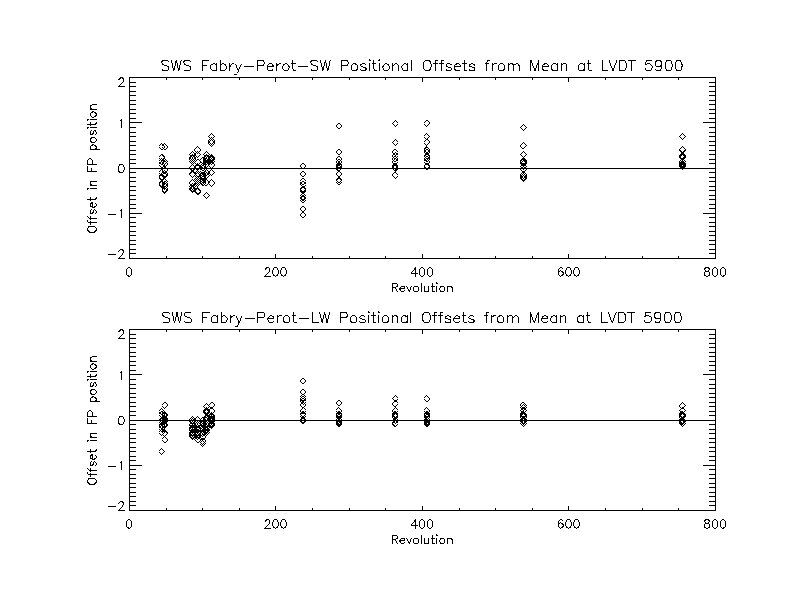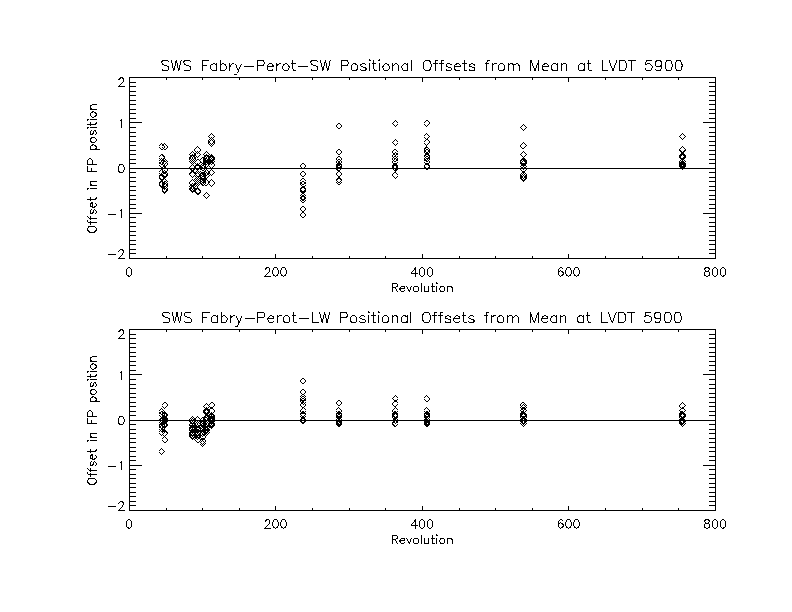05-May-1998
Status of SWS Fabry-Perot wavelength calibration and instrumental profile
=========================================================================
Author: H. Feuchtgruber
0) Introduction and Purpose
This report represents an update of the respective part of the PV report on
the same topics. Results of all dedicated internal measurements are included.
For external calibrations, a set of observations is included, demonstrating the
validity of the internal calibration throughout the mission. The calibration
is within specification, however of course, much more data on external sources
exists which could be used to confirm or improve the achieved accuracy, but
time did not yet allow to go for that.
1) FP parallelisation and instrumental profile
The parallelisation of both SWS FP sections is considered to be at an optimum
for the specified scanranges throughout the whole mission. It was done once in
PV and then only checked via the regular CAP6332 measurements. The instrumental
profile determination CAP, which is also based on internal calibrator lines,
gives same spectral resolution values as specified in the observers manual.
FP-SW: R=41900 +- 7000 at 24.61 micron
FP-LW: R=29900 +- 3600 at 24.78 micron
The instrumental profile on external sources appeared to be difficult to
characterise, because there are hardly any strong sufficiently narrow lines
available. The spectral lines observed on the planets were either saturated or
broadened by their rotation of ~10 km/s.
However lower limits for the FP resolution could be determined by observations
of targets with intrinsic line widths of less or equal 10-15 km/s:
(Examples from selected H2O, CO2 and H2 lines)
Lambda 13.89 17.03 29.83 40.69
Lambda/DLambda >22000 >25000 >30000 >30000
There might be a couple of more targets in the ISO data base which would be
suited to get even better estimates for the FP resolution, but there is no
simple way to find those observations from scratch. Given the above
restrictions, no indications have been found so far that the FP instrumental
profile deviates from an Airy (= Lorentian) shaped profile.
2) Internal wavelength calibrations
The measurements of the internal wavelength calibrations of the SWS FP-SW and
FP-LW are completed and the data is reduced. The resulting accuracy was as
expected of the order of 1 FP scan step at 24 micron.
The measurements of the internal calibration with respect to stability indicate
no change of the wavelength scale until the end of the mission within a
fraction of a step of the FP drive. Checks were done during PV and in routine
phase. A comparison of the later ones and the ones during PV show no
significant deviation. The results of two representative measurements are
plotted in Figure 2. The vertical bars indicate the borders of the valid
scan ranges for the two FP sections. It is difficult to interpret the small
(<= 0.5 steps) deviations throughout the mission (Figure 1), as the grating
wavelength calibration has shifted a bit in time. This means that the relative
intensities of the various peaks of the FP calibration source have changed as
well (see Figure 2), being transmitted through a slightly different position
within the grating profile, causing possibly little shifts in the peak
determination. However all shifts found are well within the specified 1 FP
step accuracy.
Figure 1.

Figure 2.
 3) External wavelength calibrations
The external wavelength calibration suffers from the lack of accurate wavelength
standards needed by the FP. However the few lines where rest wavelength and
radial velocity is known accurate enough, verified the internal calibration
and the resulting accuracy is, as specified in the observers manual, better
than 1/3 of a resolution element.
External standards observed (rest wavelengths in micron):
FP-SW FP-LW
Line Lambda Source Line Lambda Source
NeII 12.81355 NGC7027 H2 S(0) 28.21883 Saturn
MgV 13.5212 NGC7027 H2 S(0) 28.21883 Jupiter
CO2 13.89 (Q) W-Hya H2O 29.83671 W-Hya
CO2 14.98 (Q) Saturn H2O 31.77205 W-Hya
H2 S(1) 17.03484 Jupiter HD R(2) 37.70155 Jupiter
H2 S(1) 17.03484 Saturn H2O 39.37496 Jupiter
H2O 20.66180 NML-Cyg H2O 40.69087 W-Hya
H2O 43.89349 Jupiter
H2O 44.19473 Jupiter
Of course, much more lines with reasonably good knowledge of rest wavelength
and radial velocity have been observed during the mission, but so far no
attempt has been made to reduce and combine all these observations into a
single consistent set of data describing the SWS FP wavelength calibration in
a more statistical way. Given the fact that the calibration is already well
within specification, this task has low priority.
4) Further documentation on that subject
PV report
Special A&A issue, A&A, 315, L60
3) External wavelength calibrations
The external wavelength calibration suffers from the lack of accurate wavelength
standards needed by the FP. However the few lines where rest wavelength and
radial velocity is known accurate enough, verified the internal calibration
and the resulting accuracy is, as specified in the observers manual, better
than 1/3 of a resolution element.
External standards observed (rest wavelengths in micron):
FP-SW FP-LW
Line Lambda Source Line Lambda Source
NeII 12.81355 NGC7027 H2 S(0) 28.21883 Saturn
MgV 13.5212 NGC7027 H2 S(0) 28.21883 Jupiter
CO2 13.89 (Q) W-Hya H2O 29.83671 W-Hya
CO2 14.98 (Q) Saturn H2O 31.77205 W-Hya
H2 S(1) 17.03484 Jupiter HD R(2) 37.70155 Jupiter
H2 S(1) 17.03484 Saturn H2O 39.37496 Jupiter
H2O 20.66180 NML-Cyg H2O 40.69087 W-Hya
H2O 43.89349 Jupiter
H2O 44.19473 Jupiter
Of course, much more lines with reasonably good knowledge of rest wavelength
and radial velocity have been observed during the mission, but so far no
attempt has been made to reduce and combine all these observations into a
single consistent set of data describing the SWS FP wavelength calibration in
a more statistical way. Given the fact that the calibration is already well
within specification, this task has low priority.
4) Further documentation on that subject
PV report
Special A&A issue, A&A, 315, L60

 3) External wavelength calibrations
The external wavelength calibration suffers from the lack of accurate wavelength
standards needed by the FP. However the few lines where rest wavelength and
radial velocity is known accurate enough, verified the internal calibration
and the resulting accuracy is, as specified in the observers manual, better
than 1/3 of a resolution element.
External standards observed (rest wavelengths in micron):
FP-SW FP-LW
Line Lambda Source Line Lambda Source
NeII 12.81355 NGC7027 H2 S(0) 28.21883 Saturn
MgV 13.5212 NGC7027 H2 S(0) 28.21883 Jupiter
CO2 13.89 (Q) W-Hya H2O 29.83671 W-Hya
CO2 14.98 (Q) Saturn H2O 31.77205 W-Hya
H2 S(1) 17.03484 Jupiter HD R(2) 37.70155 Jupiter
H2 S(1) 17.03484 Saturn H2O 39.37496 Jupiter
H2O 20.66180 NML-Cyg H2O 40.69087 W-Hya
H2O 43.89349 Jupiter
H2O 44.19473 Jupiter
Of course, much more lines with reasonably good knowledge of rest wavelength
and radial velocity have been observed during the mission, but so far no
attempt has been made to reduce and combine all these observations into a
single consistent set of data describing the SWS FP wavelength calibration in
a more statistical way. Given the fact that the calibration is already well
within specification, this task has low priority.
4) Further documentation on that subject
PV report
Special A&A issue, A&A, 315, L60
3) External wavelength calibrations
The external wavelength calibration suffers from the lack of accurate wavelength
standards needed by the FP. However the few lines where rest wavelength and
radial velocity is known accurate enough, verified the internal calibration
and the resulting accuracy is, as specified in the observers manual, better
than 1/3 of a resolution element.
External standards observed (rest wavelengths in micron):
FP-SW FP-LW
Line Lambda Source Line Lambda Source
NeII 12.81355 NGC7027 H2 S(0) 28.21883 Saturn
MgV 13.5212 NGC7027 H2 S(0) 28.21883 Jupiter
CO2 13.89 (Q) W-Hya H2O 29.83671 W-Hya
CO2 14.98 (Q) Saturn H2O 31.77205 W-Hya
H2 S(1) 17.03484 Jupiter HD R(2) 37.70155 Jupiter
H2 S(1) 17.03484 Saturn H2O 39.37496 Jupiter
H2O 20.66180 NML-Cyg H2O 40.69087 W-Hya
H2O 43.89349 Jupiter
H2O 44.19473 Jupiter
Of course, much more lines with reasonably good knowledge of rest wavelength
and radial velocity have been observed during the mission, but so far no
attempt has been made to reduce and combine all these observations into a
single consistent set of data describing the SWS FP wavelength calibration in
a more statistical way. Given the fact that the calibration is already well
within specification, this task has low priority.
4) Further documentation on that subject
PV report
Special A&A issue, A&A, 315, L60